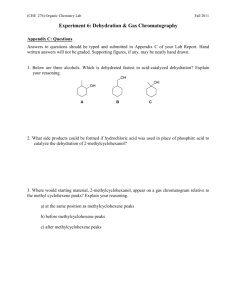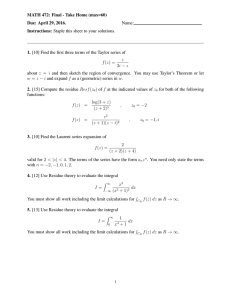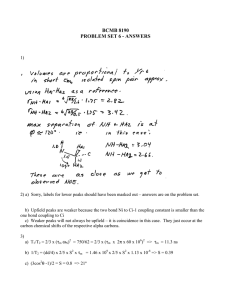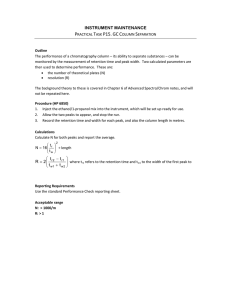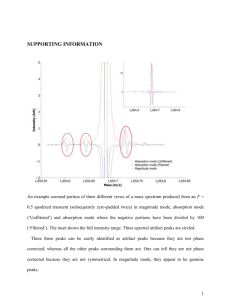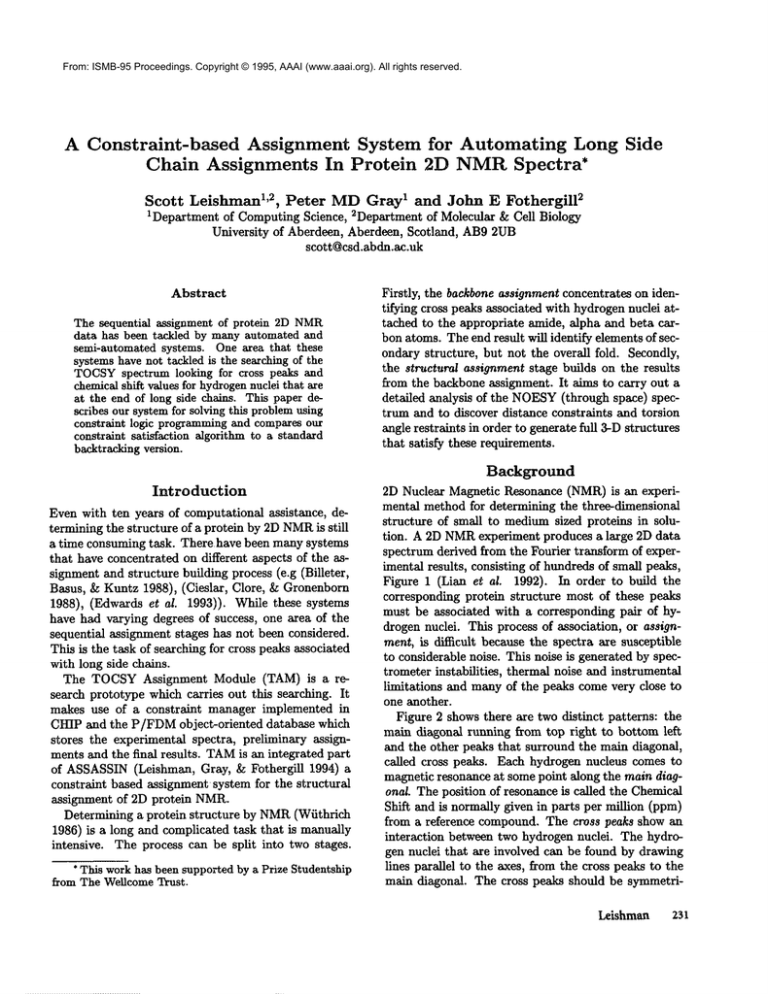
From: ISMB-95 Proceedings. Copyright © 1995, AAAI (www.aaai.org). All rights reserved.
A Constraint-based
Assignment System for Automating Long Side
Chain Assignments In Protein 2D NMRSpectra*
Scott
Leishman 1,2,
Peter
MD Gray 1 2and John E Fothergill
1Department of Computing Science, 2Department of Molecular & Cell Biology
University of Aberdeen, Aberdeen, Scotland, AB92UB
scott~csd.abdn.ac.uk
Abstract
The sequential assignment of protein 2D NMR
data has been tackled by many automated and
semi-automated systems. One area that these
systems have not tackled is the searching of the
TOCSYspectrum looking for cross peaks and
chemicalshift values for hydrogennuclei that are
at the end of long side chain~. This paper describes our systemfor solving this problemusing
constraint logic programmingand compares our
constraint satisfaction algorithm to a standard
backtracking version.
Introduction
Even with ten years of computational assistance, determining the structure of a protein by 2D NMRis still
a time consuming task. Therehave been many systems
that have concentrated on different aspects of the assignment and structure building process (e.g (Billeter,
Basus, & Kuntz 1988), (Cieslar, Clore, & Gronenbom
1988), (Edwards et al. 1993)). While these systems
have had varying degrees of success, one area of the
sequential assignment stages has not been considered.
This is the task of searching for cross peaks associated
with long side chains.
The TOCSYAssignment Module (TAM) is a research prototype which carries out this searching. It
makes use of a constraint manager implemented in
CHIP and the P/FDMobject-oriented
database which
stores the experimental spectra, preliminary assignments and the final results. TAM
is an integrated part
of ASSASSIN(Leishman, Gray, & Fothergill 1994)
constraint based assignment system for the structural
assignment of 2D protein NMR.
Determining a protein structure by NMR(Wiithrich
1986) is a long and complicated task that is manually
intensive. The process can be split into two stages.
* This work has been supposed by a Prize Studentship
from The WellcomeTrust.
Firstly, the backbone assignment concentrates on identifying cross peaks associated with hydrogennuclei attached to the appropriate amide, alpha and beta carbon atoms. The end result will identify elements of secondary structure, but not the overall fold. Secondly,
the structural assignment stage builds on the results
from the backbone assignment. It aims to carry out a
detailed analysis of the NOESY
(through space) spectrum and to discover distance constraints and torsion
angle restraints in order to generate full 3-D structures
that satisfy these requirements.
Background
2D Nuclear Magnetic Resonance (NMR)is an experimental method for determining the three-dimensional
structure of small to mediumsized proteins in solution. A 2D NMRexperiment produces a large 2D data
spectrum derived from the Fourier transform of experimental results, consisting of hundreds of small peaks,
Figure 1 (Lian e~ al. 1992). In order to build the
corresponding protein structure most of these peaks
must be associated with a corresponding pair of hydrogen nuclei. This process of association, or assignmerit, is difficult because the spectra axe susceptible
to considerable noise. This noise is generated by spectrometer instabilities,
thermal noise and instrumental
limitations and many of the peaks come very close to
one another.
Figure 2 shows there are two distinct patterns: the
main diagonal running from top right to bottom left
and the other peaks that surround the main diagonal,
called cross peaks. Each hydrogen nucleus comes to
magnetic resonance at some point along the main diagonal. The position of resonance is called the Chemical
Shift and is normally given in parts per million (ppm)
from a reference compound. The cross peaks show an
interaction between two hydrogen nuclei. The hydrogen nuclei that are involved can be found by drawing
lines parallel to the axes, from the cross peaks to the
main diagonal. The cross peaks should be symmetriLeishman
231
8.15
..OIo
7.2
6.0
4~B
35
2;2
o-
1~0
. e~e~..o’a
-0 2
-! ,5
o;i:,
-o.:~
"-ii
Lo-I
~.~
.
I
0
~ io
¯
i
ii
|I l , ’
II,
i.
" F¢:.
¯.g,
" ’"
~.B-t
s.~-t
o
91P
e/Is
J7.2
"s
¯.
_’I~’ ~ ,~=FI,’.
"." ~I."~,’
g.e-
Figure 1: TOCSYspectrum of the IgG binding domain III from Protein G.
cal about the main diagonal, but in practice this is not
true because of differences in resolution in the two axes
and noise artifacts.
Different regions of the spectrum correspond to different types of side chain atom groups that contain
hydrogen nuclei. Hydrogen nuclei along a side chain
are classified according to the carbon atom they are
attached to in the amino acid residue. Greek letters
axe used in sequence starting from the peptide carbonyl group, e.g a, 8, 7, ~, e, while the hydrogen nuclei attached to the amide nitrogen is denoted by an
N (IUPAC-IUB1970). Figure 2 shows along the axes
of the spectrum the areas where the different hydrogen
nuclei cometo resonance. It is clear that all the hydrogen nuclei that are at the end of amino acid residues
with long side chains cometo resonance in the top right
hand corner making the top right corner very crowded.
Through bond spectra,
such as COSY, TOCSYand
HOHAHA
show interactions
between the hydrogen nuclei in a single residue¯ Different residue types give rise
to different patterns of cross peaks according to their
chemical structure. The exact location of the cross
peaks which form a residue pattern, or spin-system,
cannot be predicted, but it is knownthat each cross
peak should fall in a general region of the spectrum.
Figure 3 shows the six general regions for a threonine
residue on each side of the main diagonal. It is these
spin-systems that are very important when trying to
232
ISMB-95
o
l0
~ C~mical Sa~ @.p.u~)
M~a
~’.’.~.j’.’.,~’4:" ~r"I
-/<.<:
*r.’.: /I "’.~""
".’.
./ ::..f.~.’.
a
/....
s~owthetwo
bydrogeu
nuclei
thatCalSell
this
m~ pesk
HN
!o
I ,~"
Approx.
Position
\ where
protons
a ~ Y&~~--’~~. come
todiffenmt
msonmn~
~ong
the maln
d~a~onal
Figure 2: Schematic Representation of a 2D Spectrum
showing the main diagonal and cross peaks. One specific cross peak and its corresponding hydrogen nuclei
on the main diagonal have been identified. Along the
bottom and right axis the approximate regions where
each type of hydrogen nucleus comes to resonance are
indicated.
search for cross peaks associated with resonances at
the end of side chains. In the rest of this paper the expected region where a cross peak that is part of a spinsystem should appear will be called a Residue Peak
Backbone
Assignment
1. Identification of amino-acid spin-systems
As shownin Figure3 thereis a distinctive
pattern
of rpeaks
foreachresidue
type.Thefirsttaskis to
identify
thesespin-systems
andassociate
themwith
theappropriate
residue
type.Thisis usually
possiblebecause
theamideresonances
associated
withthe
backbone
occurin a lesscrowded
region
of thespectrum. This involves COSY and TOCSY/HOHAHA
(through
bond)spectra
and concentrates
on theNH,
Calland C~H regions.
Because of the number of cross peaks it is sometimes difEcult to associate uniquely a spin-system to
a residue type (especially in the top right of spectrum). This is because several residues have similar
patterns in the NH, Call and CflHregions. To overcome this, similar spin-systems are grouped into J
(Ser, Asp, Asn, Cys, Trp, Phe, Tyr and His) and
U (Lys, Arg, Met, Gln, Glu and Pro) categories
(Roberts 1993).
Connection o] amino-acid spin-systems
.
The corresponding Call of one residue is connected
by a cross peak in the NOESYspectrum to the NH
of the next residue. By following these connections,
groups of spin-systems can be identified and matched
into the primary sequence of the protein by using the
Sequential Assignment Strategy (Wfithrich 1986).
The J and U residue types match any one of their
set of amino acid residues and are anchored in the
sequence by neighbouring connectivities.
.
Walking the Side-Chain
This step is only necessary for mediumto long sidechains and aims to identify as many of the remaining cross peaks as possible in the TOCSYor HOHAHAspectrum. For this reason it is commonly
called "walking the side-chain".
Once the J mad U residues have been placed in the
sequence it is possible to look for cross peaks associated with the specific amino acids. For example, once a cross peak has been assigned specifically
to a Met instead of a U, it is possible to search
the TOCSYspectrum for NH-CTHconnectivities
(Roberts 1993). This is achieved by using the known
cross peaks and expected full spin-system to guide a
search of the spectrum looking for other cross peaks
that are membersof the spin-system. At the end of
this phase chemical shift values should be identified
for a considerable number of hydrogen nuclei.
Overview
of TAM
Duringthe processof NMR structure
determination
it is important
to notethatthequalityof a struc-
0
(p.p.s.)
Backbone
0
Figure 3: The Rpeak regions and structure of a threonine residue. In the structure, the hydrogens that
contribute to the Rpeak regions are indicated.
ture depends on the number of NOEdistance constralnts.
These distance constraints come from the
detailed structural assignment process where as many
of the NOESYcross peaks as possible are assigned.
This has resulted in an appreciation that the number
of structural distance constraints is usually more important than their exact values (Clore, Robien, &Gronenborn 1993). Therefore an increase in the number of
known chemical shift values will lead to more NOESY
cross peaks being assigned, which in turn will lead to
more distance constraints.
This can be achieved by
trying to assign chemical shift values to as manyof the
atom groups associated with the amino acid residues
with long side chains as possible. Another advantage
of detailed cross peak assignment in the TOCSY
spectrum is that many of the cross peaks also appear in
the NOESYspectrum. Deciding which atoms correspond to a single cross peak can becomevery difficult
and human spectroscopists find it diSqcult to reason
with all the possibilities at one time. Thus it wouldbe
useful to have a semi-automatic method to assist with
searching for remaining chemical shift resonances.
The Tocsy Assignment Module (TAM) was designed
to search the TOCSYspectrum looking for cross peaks
that are part of the residue’s spin system. The output from TAMthen passes onto the structural assignment stage of ASSASSIN,which does the important
structure determination. TAM’sinitial input is some
chemical shift values and a partial set of assigned cross
peaks for each residue. This input data can either be
the result of a manual assignment or output from an
automated system (e.g. PNA(Edwards et al. 1993)).
Typically the search would be for the J and U residue
types. This task is complicated by missing peaks and
random noise.
This problem has been implemented as a Con-
straint Satisfaction Problem in the constraint logic
programming language CHIP V4.0 (COSYTEC1993).
CHIP combines logic programming with integrated
constraint solving. This means that problems can be
stated declaratively, but results are obtained in an efficient way (Van Hentenryck 1989). Specifically, CHIP
helps to solve complex combinatorial search problems
especially when using finite domain.q. In CHIPterminology, constraints between special programmingvariables (called domain variables) are used to construct
a model of the problem. Each domain variable must
have a finite number of possible values and CHIP’s
task is to find values for all the domainvariables that
satisfy all the constraints.
CHIP has been used to
tackle a wide number of different problems such as
car-sequencing (Dincbas & co workers 1988), protein
r-strand topology prediction (Clark et 02. 1993) and
job-shop scheduling (Duncan 1994). Recently the connection of amino acids in 3D CA-TOCSYand COTOCSYexperiments has been tackled as a constraint
satisfaction problem (but not using constraint logic
programming) by (Zimmerman, Kulikowski, & Montelione 1993) in the AUTOASSIGN
system.
TAMuses the P/FDM Database Management System as a database to store the experimental NMR
spectra, knowledgeof the protein sequence and the results generated. P/FDM(Gray, Kulkarni, & Paton
1992) is an implementation, mostly in Prolog, of Shipman’s (Shipman 1981) Functional Data Model. CHIP
and P/FDM have been linked by ChipLink (Leishman 1995) which allows the passing of arbitrary prolog
terms between the two systems using Remote Procedure Call.q. Specifically this allows stubs of the P/FDM
data retrieval primitives to be implemented on the
CHIPside which transparently call the corresponding
P/FDMprimitives. This architecture makes it possible to program in CHIP as if one were programming
in P/FDM, Figure 4.
User interaction with TAM
is through a graphical interface written in X/Motif. This interface is designed
to be familiar to spectroscopists and displays the current 2D NMRspectrum in a conventional format. The
interface is directly coupled into TAMand it presents
the progress of the assignment by colour coding the
cross peaks. The cross peaks can be in one of three
states: assigned, considered for assignment or not being considered at present. The cross peaks are updated
after each assignment operation.
Constraint
Representation
In constraint satisfaction problemsit is helpful to identify four characteristics
about the problem. These
are: what objects are involved; what attributes do
234
ISMB-95
VIEWER
2D NMRI
SpectrumL,2~
Displayer
[ ::
F:
TAM
.~ Database
" Management
System
P~DM
Data
Data ChipLink~Resulls
Primitive
Calls
CHIP ]
Figure 4: Architecture
of TAM
they have; what are the possible values of these attributes; and what are the constraints between the objects. Within TAMthe objects are residues in the
protein sequence; the attributes are rpeaks that correspond to the residue; the values of each rpeak are
the cross peaks on the spectrum that correspond to
the area where the rpeak is expected to appear; and
the constraints determine that no cross peak be assigned twice and that the numberof rpeak regions that
are allowed to have a missing cross peak is set. The
constraint describing the maximumnumber of unobserved cross peaks is very important when searching
noisy data because it is very unlikely that all the rpeak
regions will have an unique cross peak.
Before the constraints amongthe rpeak regions can
be posted the domains must be set. It is possible to
divide the TOCSYspectrum into rpeak regions by using published statistical
tables of mean and standard
deviations of chemical shifts (Grot] &Kalbitzer 1988).
Therefore, it is possible to find each cross peak which
lies in a particular rpeak region. Each cross peak is
identified by a unique spectrum-wide integer, and the
group of cross peaks within an rpeak region can easily
be converted into an integer domain for the domain
variable representing that rpeak region.
Figure 3 shows that even for relatively simple amino
acids the rpeak regions overlap. If a cross peak is a
member of multiple rpeak regions then when it has
been assigned in one rpeak region, it should be removed
from consideration in the remaining rpeak regions. To
model this fact that a cross peak can only be assigned
to one rpeak region we can use the 021different constraint in CHIP. This symbolic constraint implements
forward checking because as soon as one domain variable becomes instantiated,
the domain of all remain-
ing domain variables is restricted.
The grouping of
cross peaks into potential rpeaks can take a considerable amountof time to calculate, so to remove this unnecessary overhead each time the program is run, the
results are calculated once and stored in the database.
The constraints used to enforce the maximumnumber of rpeaks that can be left unassigned are set up
when the CHIPdata structures are created. Included
in the domainof each rpeak is an integer value that is
used to represent an unobserved cross peak. It is important to represent an unobserved cross peak because
CHIPwill generate a fail if a domain-variable’s domain
is empty. These values must be unique so they do not
interact in the alldifferent constraints. The value that
is assigned to it is calculated using:
MissingValueis 50000 + (Pos * I00) + Count,
where Pos is the amino acid sequence number of the
current residue, Count is an integer incremented from
one for each rpeak region associated with each residue
and 50000 is a constant greater than any cross peak
number.
This representation
makes it easy to impose constraints on a group of rpeak domain variables. For
example, if we wanted to say that at most MaxMissing
rpeaks could be missing in a single residue (Residue)
we could represent it as a CHIPconstraint over integers thus:
8. UNTIL( all residuesassigned
9. write resultsback to P/FDM
Firstly, the NMR
spectral data and previous assignment data must be loaded from P/FDMand the appropriate CHIPdata structures created (for example see
(Leishman, Gray, & Fothergill 1994)). Next the necessary CHIPconstraints are posted and the domain of
each rpeak is limited as muchas possible by calling
propagate_aU_known_cs_valuesfor eacJa residue. Then,
the most promising residue likely to cause fewest problems for assignment is selected and assignment proceeds. This allows concentration on the easier spin
systems, before moving on to the more difficult ones,
such as lysine, arginine and proline. The selection continues for the remaining residues until they have all
been assigned. Finally the results of the assignments
are sent back to P/FDMand stored for future use.
Searching for cross peaks in spin-systems has been
implemented by a number of Prolog rules. These
rules are specific for each residue type and are constructed from primitive operations carried out by 2D
NMRspectroscopists.
These primitive operations are
described below:
1. choose_smallest
Compares two regions and returns the region with
the smallest number of unassigned cross peaks. This
rule aims to reduce the search combinatorics by
working with a smaller set of peaks first. On backtracking the alternative region is returned.
sum_rpeaks_domain_variables
(Residue,Total),
Total #< (MaxMissing+ I)
¯ (50000 + (Pos * 100))
Rather than including all the rpeak domain variables in the list, we could exclude rpeak domainvariables that must be present t’o identify the spin-system.
Therefore, we have a flexible way of imposing which
rpeak domain variables can and cannot be allowed to
be missing.
.
Assign chooses a cross peak in a rpeak region and assumes(subject to backtracking) that it is the correct
assignment.
°
propagate
Propagates an assignment into the relevant rpeak
regions. It takes a knownchemical shift value and
collects all the rpeak regions that involve this atom
group. For each rpeak region it locates all the cross
pe~s with the same chemical shift as the assigned
hydrogen nucleus and removes the rest from the domain. A margin of error is allowed because cross
peaks can often drift slightly within the spectrum.
Implementation
The high level tasks performed by TAMare described
in the following pseudo code.
I. load spectrumand currentchemical
shift values from P/FDM
2. create CHIP data structures
3. impose rpeak region constraintsusing
alldlfferent
4. call propagate_all_known_cs_values
for
each residue
5. REPEAT
6.
choosebest remainingresidue
7.
assignbest remainingresidueusing
residue_assign
ass~
.
propagate_alLknoum_cs_values
Propagates all knownassignments into all the rpeak
regions. This rule aims to make full use of any constraints on a residue’s rpeak regions and reduces
their domains as much as possible. It takes each
each knownchemical shift value and calls propagate.
Leishman
235
5. COnflrYgt
Aims to backup an assignment by identifying
peak in a symmetrical rpeak region.
assign(region(’g*’,
n), Residue2)
assign(reglon(n,
’g*’), Residue2)
~, a), Residue2)
assign(region(’g*
assign(region(a¯
’g*’), Residue2)
asslgn(region(’g*’,
b), Residue2)
assign(region(b,
’g*’), Residue2)
assign(region(n,
b), Residue2),
assign(region(b,
n), Residue2),
assign(region(a,
b), Residue2),
assign(region(b,
a), Residue2).
a cross
6. additional_peak_missing
Adds extra constraints to enforce the maximumand
minimumnumber of rpeak regions that are missing.
7. lower_value
Acts as a filter after a cross peak has been assigned.
It takes two hydrogen nuclei names and makes sure
that the first hydrogen nuclei’s chemical shift value
is lower than the second. This is particularly useful
in assigning an arbitrary ordering to a sterospecifie
assignment or as an extra help to an assignment rule
if it is knownthat one hydrogen nuelei’s chemical
shift values axe always lower than anothers.
The exact representation of the assignment of a single residue type is covered in detail below. The following example shows how the primitive operations can
be combined for threonine residues (Figure 3). While
threonine does not have a long side chain, it is used
here as an example because of its simple structure.
Similar rules are being implementedfor all amino acid
residues.
~. -- AssumesThreonineamide and alpha
~. -- chemicalshiftvaluesknown
residue_assign(thr(n,a),
Residue¯Residue2):Y. -- Section1
additional_peak_missing(thr,
Residue),
~. -- Section2
choose_smallest
(
[region(’g*’,n), region(n,’g*’)],
Residue,Smallest),
assign(’g*’,Smallest,Residue,Residue1)
propagate
( ’ g*’
[region(’g*’,n),
region(’g*’,
region(’g*’,b),
region(b,’g*’),
region(a,~g*~), region(n¯’g*~)]¯
Residuel),
-- Section3
choose_smallest
(
~ ,b)¯ region(b,’g*’)],
[region(’g*
Residuel,Smallest1),
assign(b¯Smallest1,Residue1,Residue2)¯
lower_value(~g*~,
b, Residue2)
propagate(b,
~, b), region(b,’g*’),
[region(~g*
region(n,b), region(b,
region(a,b)¯ region(b¯a)],
Residue2)
Y. -- Section4
236
ISMB-95
The above Prolog rule has been separated into four
sections. The first section imposes the miIfimumnumber of rpeak regions to be left -n~qsigned; sections two
and three are responsible for assigning chemical shift
values for g*, b atom groups respectively; and section
four gives specific assignments to remaining rpeak regions. These three general tasks will be discussed in
more detail.
,
Set Numberof rpeak regions left unassigned
Whenthe residue data structure is created the maximumnumber of rpeaks that are allowed to be missing is set. Whenwe come to search for the cross
peaks we want to start off looking for a solution that
has all the rpeak regions of a spin-system assigned
to a cross peak. This is done by imposing a more
restrictive constraint on the rpeak region’s domain
variables which says only N rpeaks are allowed to be
missing. If this is not possible the rule backtracks
and the primitive then allows one more rpeak region
to be missing. This backtracking continues until either the residue has been assigned or until the rule
reaches the maximumnumber of missing rpeak regions and the whole assignment rule backtracks. As
an efficiency consideration to prevent thrashing, the
primitive sets the minimumnumber of rpeak regions
that are allowed to be missing. Without this constraint the search space for one missing rpeak also
includes the search space for zero missing rpeak regions, and the search space for two missing rpeaks
includes the search space for zero and one missing rpeaks. This extra constraint (illustrated below
for threonine residues) overcomes the problem very
cleanly.
additional_peak_missing(thr,Pos,Residue):sum-rpeaks-d°main-varlables(Residne’
Total),
member(Missing¯
[0, 1, 2, 3, 4, 5, 6]),
Max is (Missing+l)*(50000+(Pos*100))-l,
Total #< Max,
Min is Missing*(5OOOO+(Pos*lO0))¯
Total #> Min.
2. Single atom group assignment
For each atom group we enter a standard set of operations. Firstly a number of regions are examined to
find the smallest region. This is an attempt at controlling the combinatorics by always working with
as small a domain of cross peaks as possible. From
this smaller region a single cross peak is chosen by
assign. This effectively calls CHIP’sindomainto return a viable cross peak from the domain. Notice
that in section 3 a call to lower_value is made to
filter any assignments to make sure that the C_fH
chemical shift is less than the CTHchemical shift
value.
Next, propagate is called to apply extra constraints
as a consequence of the selection. Finally, if the
regions in choose_smallest are symmetrical and the
size of the rpeak region has not been reduced by two
chemical shift values intersecting, confirm is called
to search for a cross peak in the alternative region.
Failure is likely in propagate or lower_value when
the number of allowable missing rpeaks is exceeded.
This causes classic Prolog backtracking into assign
and another cross peak is chosen. There are also a
numberof different assignment rules for each residue
type that follow alternative assignment strategies.
The advantage of CHIPis that it is being used to detect failures early on, and thus avoid the extra time
a pure backtracking search would spend in fruitless
assignments and then have to backtrack much later.
3. Specific Assignments
Once all the assignments have been propagated,
there could still be a numberof rpeak regions that do
not have an unique assignment. This happens when
then there are a few peaks very close or overlapping.
This final assign stage explicitly chooses one of these
assignments.
An example of tracing through the assignment rule
for alznine is shown in (Leishman, Gray, & Fothergill
1994).
System
Performance
Weare currently working with two simulated sets of
test data for a 16 residue chain. One is an idealised
data set that has all the necessary cross peaks in the
correct rpeak regions, the other is a subset of an actual
TOCSYspectrum (Figure 1). This second data set
was constructed by extracting the corresponding cross
peaks that were present in the actual TOCSYspectrum and adding an extra 10% random noise peaks.
While the second data set is not a "full" spectrum it
does represent the problems of a real data set with
noise and missing peaks. The number of residues represented in this data set are Thr (7), Ala (5), Val
Lys (2) giving about 400 cross peaks.
The assignment tests we have run compare the time
and number of backtracks of the CHIPversion of TAM
versus a standard backtrack Prolog version. This is
similar to the comparison protocol adopted by Van
Henteuryck (Van Hentenryck 1989). The standard
backtracking version is identical, except that the constralnts have to be used in a checking rather than
an active way. This effectively means that after each
residue_assign, the constraints to prevent a cross peaks
appearing in more than one rpeak are checked; and after each assignment primitive the number of rpeaks
assigned to be missing is checked.
It should be noted that we have not made a "strawman" out of the standard backtracking version in order
to show the superiority of CHIP. The major difference
is that assignments in one rpeak are not propagated
through all the other rpeaks. This is a form of constraint propagation mad would break away from our
aim to compare a constraint propagation version with
a standard backtracking version.
For Thr, Ala and Val, the chemical shifts and cross
peaks according to the NHand Call hydrogens were
given, and for Lys the Call chemical shifts were also
given. Typically, the system would always be started
with at least the NH, Call and Call chemical shifts and
appropriately assigned cross peaks. Weare starting
from Call to compensate for the relative shortness of
the residues in this simulated data set and to show
proof of concept.
With this relatively small sample size exact numbers
of backtracks and timings are susceptible to peak ordering and the position of noise peaks. Our general
conclusions show that the standard backtracking version, carries out considerably more backtracks than the
CHIPversion and exhibits thrashing.
This is primarily due to the inability of the standard
backtracking version to actively make use of the minimumnumber of rpeaks that are allowed to be missing.
It is easy enough to detect when the maximumnumber
of rpeaks allowed to be missing has been exceeded, but
it is only possible to check if the minimumnumber of
rpeaks has been exceeded once all the rpeaks have been
given a value. As stated before, without this ability
the search space expands exponentially. Further tests
with a number of different spectra are being planned
and should produce a quantitative analysis of the two
versions.
Leishman
237
Discussion
The CHIP system easily outperforms the standard
backtracking version, but it still does takes a considerable amount of time. One reason for this is that
the solution space is not drastically reduced once the
constraints are initially applied. Instead, the domain
variables are knownbut the extra constraints emerge
as the search progresses. A similar problem was noted
in AUTOASSIGN(Zimmerman, Knlikowski,
& Montelione 1993).
NMRspectroscopists commonlyuse multiple spectra
in their analysis and this is an area we are considering.
Spectra collected at different experimental conditions
or in different solutions (e.g. H20 and D20) give
clearer overall view of the spectra and can overcome
systematic noise effects. Our current spectra were collected in H20 and suffer from a water resonance band
(w2=4.5-6.0 ppm) which removes all cross peaks
that area.
Currently our test data only has two examples of
long lysine side chains. The assignment rules for the
lysine residue are considerably longer than the threonine example because it can have over 50 rpeak regions in its spin-system. The generation of alternative assignment rules seems relatively straightforward
though perhaps time consuming. Weare investigating
the use of a graphical way in which the rules can be
constructed in a visual programming manner.
TAMis the first stage of ASSASSIN(Leishman,
Gray, & Fothergill 1994) and was designed to convert the results from the backbone assignment to input
into the Structural Assignment Module (SAM). SAM,
along with the Structural Refinement Module (SRM),
cooperatively tackle the structural assignment loop by
analysing the NOESYspectrum, generating 3D models
(using X-PLOR(Briinger 1992)) and then reviewing
the structures to identify possible mistakes and errors.
Thus the two parts (TAMand SAM)have been implementedas different constraint satisfaction problems using CHIP. Implementation of SAMshowed that CHIP
was very successful with handling the strong geometric constraints from the NOESYspectrum and structural models. However, it needs a fairly well assigned
TOCSYspectrum to get started. TAMhelps significantly in this process, once again proving the value of
CLP,but the constraints available are not as strong as
the geometric ones. Thus we have to be satisfied with
only a partial solution, but it is nevertheless crucial for
the overall working of the system.
Acknowledgments
Special thanks to D. Norman (Biochemistry Department, University of Dundee) for his discussions and
238
ISMB-95
assistance.
Weare grateful to L.-Y. Lian, G.C.K.
Roberts (Biological NMRCentre and Department of
Biochemistry, University of Leicester) and E. Lane and
A. Raine (Cambridge Centre for Molecular Recognition, Department of Biochemistry, University of Cambridge) for our 2D NMRexperimental data.
References
Billeter, M.; Basus, V.; and Kuntz, I. 1988. A Program for Semi-automatic Sequential Resonance Assignments in Protein 1H NMRNuclear Magnetic Resonance. J. Magn. Reson. 76:400-415.
Briinger, A. 1992. X-PLORManual version 3.0. Yale
University, NewHaven, CT.
Cieslar, C.; Clore, G.; and Gronenborn, A. 1988.
Computer-Aided Sequential Assignment of Protein
1H NMRSpectra. J. Magn. Reson. 80:119-127.
Clark, D.; Rawlings, C.; Shirazi, J.; Veron, A.; and
Reeve, M. 1993. Protein Topology Prediction through
Parallel Constraint Logic Programming. In Hunter
et al. (1993), 83-91.
Clore, G.; Robien, M.; and Gronenborn, A. 1993.
Exploring the Limits of Precision and Accuracy of
Protein Structures Determined by Nuclear Magnetic
Resonance Spectroscopy. J. Mol. Biol. 231:82-102.
COSYTEC.1993. CHIP V4 User’s Guide. Technical
report, COSYTEC
SA, Parc Club Orsay Universite,
France.
Dincbas, M., and co workers. 1988. The Constraint
Logic Programming Language CHIP. In Proceedings
o] the International Conference on Fifth-Generation
Computing Systems.
Duncan, T. 1994. Intelligent
Vehicle Scheduling:
Experiences with a Constraint-based Approach. In
Milne, R., and Montgomery, A., eds., Applications
and Innovations in Expert System -- Proc. ES’9,~
Volume II, 281-291. Cambridge: SGESPublications.
Edwards, P.; Sleeman, D.; Roberts, G.; and Lian, L.Y. 1993. An AI Approach to the Interpretation
of
the NMRSpectra of Proteins. In Hunter, L., ed., AI
and Molecular Biology. AAAI/MITPress. 259-288.
Gray, P.; K1jlbarni, K.; and Paton, N. 1992. ObjectOriented Databases: a Semantic Data Model Approach. Prentice Hall Series in Computer Science.
Prentice Hall International Ltd.
Grofl, K.-H., and Kalbitzer, H. 1988. Distribution of
Chemical Shifts in 1H Nuclear Magnetic Resonance
Spectra of Protein. J. Magn. Reson. 76:87-99.
Hunter, L.; Searls, D.; and Shavlik, J., eds. 1993.
First International Conference on Intelligent Systems
for Molecular Biology. AAAIPress.
IUPAC-IUB. 1970. Abbreviations and Symbols for
the Description of the Conformation of Polypeptide
Chains. Biochmistry 9:3475.
Leishman, S.; Gray, P.; and Fothergi]l, J. 1994. ASSASSIN: A Constraint Based Assignment System for
Protein 2D Nuclear Magnetic Resonance. In Milne,
R., and Montgomery, A., eds., Applications and Innovations in Expert System -- Proc. ES’9~ Volume
II, 263-280. Cambridge: SGESPublications.
Leishman, S. 1995. ChipLink User Manual. Technical
report, University of Aberdeen, Dept. of Computing
Science, King’s College, Aberdeen, U.K.
Lian, L.-Y.; Derrick, J.; Sutcliffe, M.; Yang, J.; and
Roberts, G. 1992. Determination of the Solution
Structures of Domains II and III of Protein G from
Streptococcus by 1H Nuclear Magnetic Resonance. J.
Mol. Biol. 288:1219-1234.
Roberts, G., ed. 1993. NMRof Macromolecules. Oxford University Press.
Shipman, D. 1981. The Functional Data Model and
the Data Language DAPLEX.ACMTransactions on
Database Systems 6(1):140-173.
Van Henteuryck, P. 1989. Constraint Satisfaction
Logic Programming. MIT Press.
Wiithrich, K. 1986. NMRof Proteins
Acids. Wiley, NewYork.
in
and Nucleic
Zimmerman,D.; Kulikowsld, C.; and Montelione, G.
1993. A Constraint Reasoning System for Automated
Sequence-Specific Resonance Assignment from Multidimensional Protein NMRSpectra. In Hunter et al.
(1993), 44?-455.
Leishman
259

